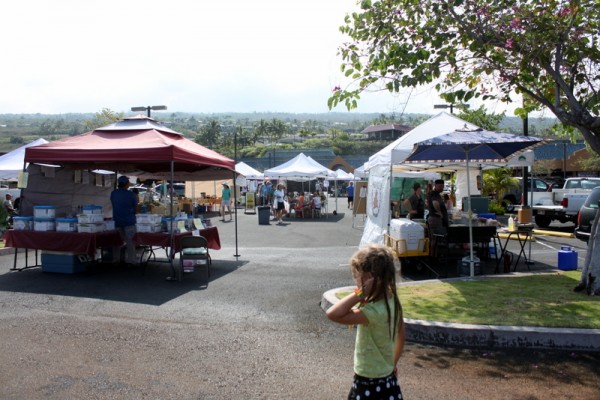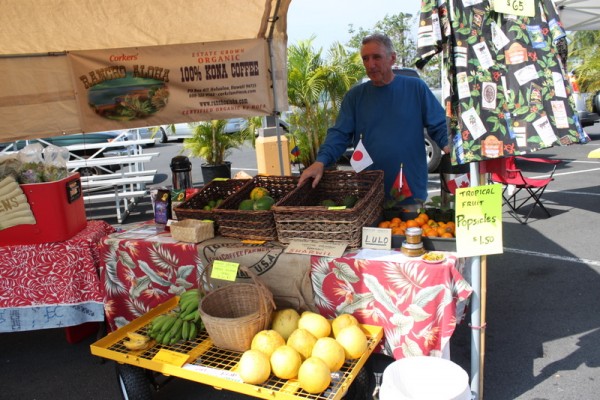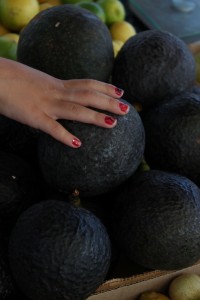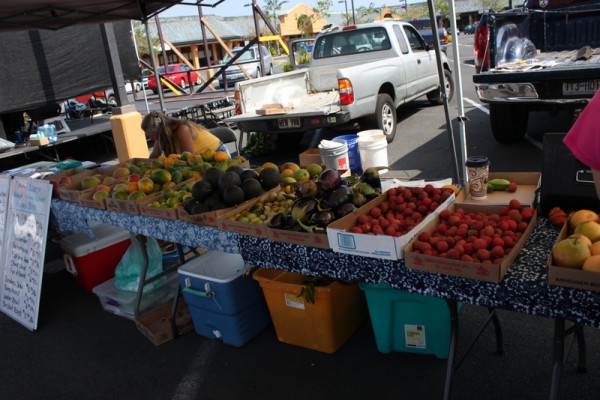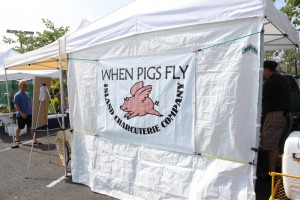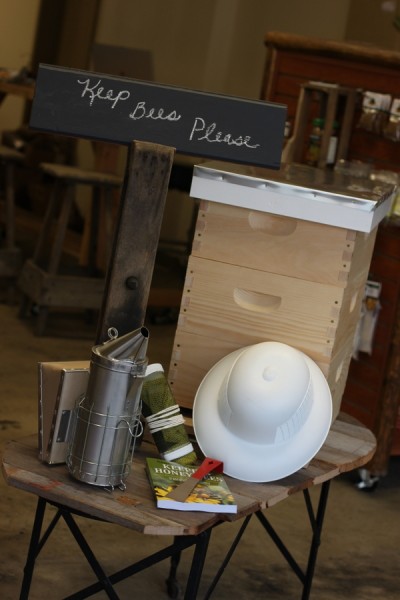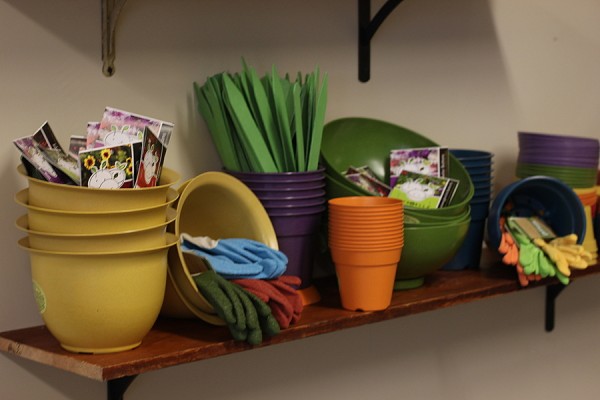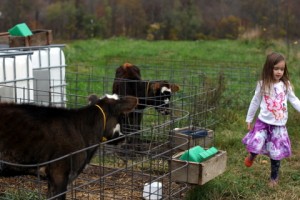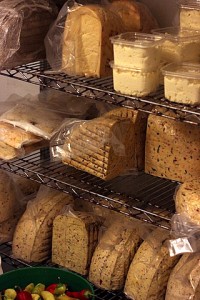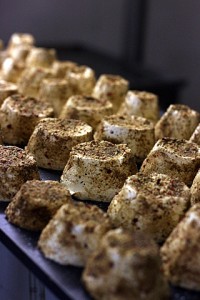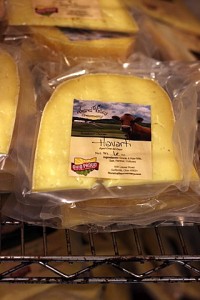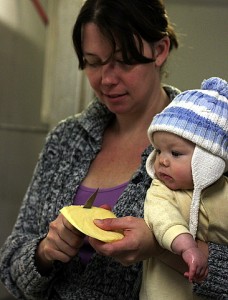Scenes from the Keauhou Farmers Market on yesterday's very sunny morning. 1) row of stands on hot black pavement. 2) Rancho Aloha farmer gave me seeds for lulo fruit 3) Kona macadamia nuts 4) huge cheap avocados 5) Display of lychee, avocados, mangos, and passionfruit 6) When Pigs Fly delicious charcuterie 7) edible orchids 8 ) Lil with her goodies - a lei, perfume, and tiny pineapple
Farmers' Market Fresh - How to Store & Preserve Produce
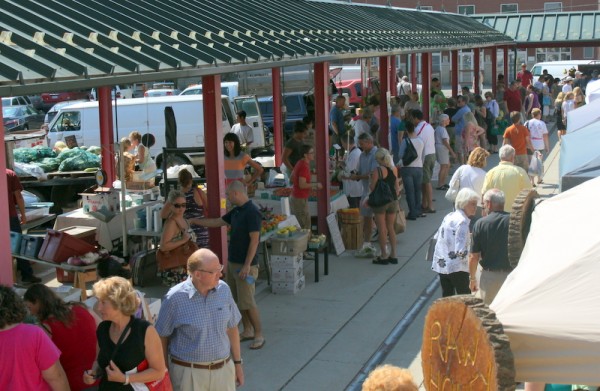 Choosing delicious seasonal fruits and vegetables from farmers' markets and CSAs is an investment of time and money, a commitment that keeps dollars in the local economy, supports sustainable agriculture, and helps people have a healthy diet. There is much to learn about what's available when and who to buy it from. I recently contributed 'How to Shop A Farmer's Market Like a Pro' guide on Once a Month Mom with my top tips for feeling comfortable at farmers' markets.
Choosing delicious seasonal fruits and vegetables from farmers' markets and CSAs is an investment of time and money, a commitment that keeps dollars in the local economy, supports sustainable agriculture, and helps people have a healthy diet. There is much to learn about what's available when and who to buy it from. I recently contributed 'How to Shop A Farmer's Market Like a Pro' guide on Once a Month Mom with my top tips for feeling comfortable at farmers' markets.
The dedication to local food doesn't stop at the farmers' market or CSA pick up. Once the hand-picked produce is home, cooks want to use the fruits and vegetables to their full potential without waste.
Farmers' Market Fresh
Sensing a need, I created Farmers' Market Fresh, a guide to storing and preserving Midwestern seasonal produce. My one-page chart details how to keep fruits and vegetables freshest, how long you can expect them to last, and suggestions for long-term preservation.
Click on the icons in the top right to expand Farmer's Market Fresh on your screen. If you want a print copy (how exciting to think this might end up on someone's fridge!) download the seasonal produce guide as a printable .pdf.
Will you use the Farmers' Market Fresh guide? How do you get the most out of farm fresh produce?
PS. My farmers' market (Clintonville) starts tomorrow from 9 am to noon! I am so excited to be selling seedlings, microgreens, and mushrooms with Swainway Urban Farm. Stop by our booth at Dunedin and High (on the side of Global Gallery coffee shop) and say hello.
Food Dialogues with US Farmers and Ranchers Alliance
 Do you know about the US Farmers and Ranchers Alliance (USFRA)? It is a newly created umbrella organization of state farm bureaus and grower's councils. Their mission is to "lead the dialogue and answer Americans’ questions about how we raise our food". Their new website Food Dialogues is designed to help facilitate conversations about how people, the planet, and businesses are affected by agriculture.
I have been a member of the Ohio Farm Bureau (OFB), member of USFRA, for over a decade. This relationships started because of their Nationwide insurance discounts and continues because I want to be part of the food culture in Ohio.
Do you know about the US Farmers and Ranchers Alliance (USFRA)? It is a newly created umbrella organization of state farm bureaus and grower's councils. Their mission is to "lead the dialogue and answer Americans’ questions about how we raise our food". Their new website Food Dialogues is designed to help facilitate conversations about how people, the planet, and businesses are affected by agriculture.
I have been a member of the Ohio Farm Bureau (OFB), member of USFRA, for over a decade. This relationships started because of their Nationwide insurance discounts and continues because I want to be part of the food culture in Ohio.
Conflicted History
My feelings about the Ohio Farm Bureau, and hence the USFRA, are mixed, though. While the OFB presents the stories of friends Sippel Family Farm and Marilou Suszko in their lovely and informative Our Ohio magazine, the values advocated by OFB are often out of line with my own. I passionately argued against the intrusion of 'livestock care board' into the Ohio state constitution while the Farm Bureau helped deceive Ohioans into voting for Issue Two a few years ago. Similarly, while I believe in the rights of workers to organize, the Farm Bureau presented anti-union arguments in last fall's Ohio Senate Bill 5. I truly couldn't understand their position on SB 2, as the farm bureau itself is an organization of workers.
The USFRA is made up of other groups that ruffle my feathers, including Monsanto, Dow AgriSciences, and DuPoint as "Industry and Premier Partners". Behind the scenes, these monied and influential businesses promote agricultural bills that generally work against the diverse, organic, small farms that I believe are healthiest for farmers, consumers, and the environment.
Continue the Conversation
Despite conflicts, I believe that staying in the discussion is important. If local food advocates turn their backs on the USFRA, our voice will be lost. Perhaps by making some noise about what we want to see in the food system, we can affect change.
There are so many reasons to speak up. The honeybees and rivers need advocates to call attention to how farm waste can affect species far from farm sites. People who do not have the time or courage to speak up - the working poor, undocumented immigrants, and children - need us to insist on affordable food that does not compromise human and environmental health. People like me who care about antibiotic overuse must speak up for the farm animals who are given disturbing quantities and varieties of medicines to stay alive during stressful raising conditions. Farmer workers themselves, sometimes locked into contracts to use products that may be harmful to their personal health, need consumers to demand safe growing conditions.
The USFRA is hosting conversations virtually at Food Dialogues and on their facebook page. I set up my profile and joined the Facebook page to ask questions like:
- How will the USFRA support and grow the number of small organic farms in the US?
- Why is there arsenic and antidepressants in chickens and what is the USFRA doing to stop this practice?
- How can environmental protection be promoted when agricultural subsidies encourage over-production?
- Transporting livestock to slaughter, produce across the country, and even farm workers between farms uses an excessive amount of fossil fuels. The Eat Local movement reduces this demand. How will the USFRA support reduced 'food miles'?
- Why are there no councils or groups of produce growers in the USFRA? Maybe if a vegetable council promoted fresh produce, Americans would have more access to affordable fresh food.
Please join me in dialogue about growing food in the US. Leave a comment below (about agriculture, food, or anything you like) and enter to win a prize package of a Crock-Pot Programmable 6-Quart Slow Cooker and two reusable designer shopping bags from Envirosax.
Giveaway details: Prize package is a Crock-Pot Programmable 6-Quart Slow Cooker and two reusable designer shopping bags from Envirosax. Prize Pack ERV - $68. Prize is provided and delivered by USFRA; Entrants agree to not hold Rachel Tayse Baillieul or Hounds in the Kitchen liable for the prize. Entry open to US resident adults 18 years of age and older. Entries as comments on this site will be accepted from 10 am EST Wednesday April 11, 2012 - 10 am EST Wednesday April 18, 2012. One winner will be chosen on Wednesday April 18, 2012 by random.org and notified via email. In the event that a winner does not respond within 48 hours, a new winner will be selected.
Disclosure: The US Farmers and Ranchers Alliance paid me a stipend to introduce readers to their Food Dialogues website and Facebook page. All opinions are clearly my own.
City Folk's Farm Shop First Look
 City Folk's Farm Shop opens today in North Clintonville. Located at 4760 North High Street, at the intersection of Beechwold and High, City Folk's is a sustainably-minded urban homesteading store. They stock gardening, house keeping, and animal husbandry supplies for central Ohio backyard growers. Lil and I stopped in yesterday to see the store before the soft opening.
City Folk's Farm Shop opens today in North Clintonville. Located at 4760 North High Street, at the intersection of Beechwold and High, City Folk's is a sustainably-minded urban homesteading store. They stock gardening, house keeping, and animal husbandry supplies for central Ohio backyard growers. Lil and I stopped in yesterday to see the store before the soft opening.
It's hard not to scheme and dream in City Folk's. Tucked into corners of the store are charming handmade bat, bee, bird, and worm houses. A rack on the wall holds the most rustically beautiful hand tools I have ever seen. Everything a homesteader needs from laundry detergent to cheese making supplies to dehydrators are stocked in the welcoming, well lit show room.
Seeds from a variety of organic and heirloom producers are stacked in colorful packages just waiting to burst into plants. Pots in a variety of sustainably sourced materials are available to fill with bulk or bagged organic soil.
The back of the store houses a selection of chicken feed, soil, and amendments that can be loaded right out the back door into the parking lot.
City Folk's Farm Shop obviously has a preference for local, sustainably made tools - a preference I share. Shop keeper Shawn is committed to providing what local homesteaders need and welcomes our ideas. She put together a schedule of educational events to be held in store, including Backyard Chicken Basics (April 15, 3:30-4:30 pm) and Homesteading with Children (June 3, 3:30-4:30 pm) led by yours truly. See the full calendar on the City Folk's event page.
City Folk's opens today with hours from 10 am - 6 pm. They are planning a grand opening celebration for Earth Day weekend, April 21-22. Visit soon to outfit yourself for the spring growing season.
Disclosure: City Folk's hired me to write copy for their website and manage their social media account during opening. This post was not part of our agreement and opinions are my own.
Want to Buy the Homestead? And Other Updates
 Homestead for Sale
Homestead for Sale
We are finally putting our Clintonville house on the market very soon. In the meantime, life is a blur of paint and trim and organization.
The new buyers of the hound homestead will move into a home complete with:
- two rainbarrels
- seven fruit trees
- dozen perennial edibles
- seven raised beds with organic soil
- compost bin
- wood stove and what's left of the ash wood pile
- kitchen designed for serious cooking and canning
- new insulated windows and doors
- two car garage with built in workbench
If you are in the market for a house and want to choose finishes like paint and a little bit of flooring, let's talk ASAP.
In Other News
In addition to my role as chief house stager, I am working with three social media clients: City Folk's Farm Shop, OCS Logistics, and C-PAP Central Online. It is exciting to guide small businesses in the world wide web.
I also accepted a role with Swainway Urban Farm to assist at farmer's markets. Our first date is the Clintonville Sprout Swap on April 28! I am a huge fan of Joseph's growing philosophy and can't wait to help him share organic seedlings, produce, and mushrooms with the Clintonville and New Albany market shoppers.
As if life couldn't be more busy, we decided on our last trip (this past weekend to Indianapolis) to start a family travel blog. Lil will take videos, Alex contribute quick posts on the road, and I'll manage the whole thing. Check out Curious Wanderlust for our very first updates.
Thanks for hanging in with the website updates during the hosting transition. I'm in the process of transferring to a new-new host with the old-new theme and everything will look normal again soon.
Laurel Valley Creamery {Farm Profile}
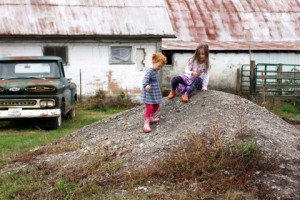 Nestled around soft Southern Ohio hills there is a winding road that leads to Laurel Valley Farm and Creamery. On one side of the rumbling stone lane is the farm house, creamery rooms, and calf pens. On the other, the milking barn.
Nestled around soft Southern Ohio hills there is a winding road that leads to Laurel Valley Farm and Creamery. On one side of the rumbling stone lane is the farm house, creamery rooms, and calf pens. On the other, the milking barn.
Cows to Cheese
Celeste and Nick Nolan manage the farm that has been in Nick's family for decades. They express gratitude that they are able to carry on the family tradition but also frustration with the facilities that were left in decline for some time.
Nick is the cow man. He raises calves, moves the herd around the pastures and milks the cows daily. The pastured raw milk rests in a huge container that holds it at a chilled temperature until Celeste makes it into cheese.
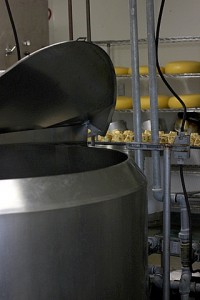 The creamery is a converted outbuilding that now houses three rooms. In the first, Celeste adds culture into raw milk. Depending on the desired cheese variety, the milk is heated, stirred, cut into curds, pressed and/or flavored with locally grown herbs and peppers.
The creamery is a converted outbuilding that now houses three rooms. In the first, Celeste adds culture into raw milk. Depending on the desired cheese variety, the milk is heated, stirred, cut into curds, pressed and/or flavored with locally grown herbs and peppers.
Some cheeses go from the processing room to the curing and aging room. Large rounds are brined and allowed to dry and age on wire racks.
All cheese ends up in the storage room labelled with a hand-lettered Laurel Valley label featuring a sweet cow face. Some is packaged in bulk for resale to restaurants. Others find their way directly to customers at farmers markets and grocers.
Variety Notes
All Laurel Valley cheeses are raw and simple to allow the flavor of the full fat grass-fed milk to shine through. These are true farmstead cheeses.
Laurel Valley makes several flavors of cheese curds. Fresh cheese curds are a rare treat; Laurel Valley's are squidgy, salty, super little bites. Enjoy curds as a snack, salad topping, or part of my favorite Canadian speciality, poutine.
Cloverton is a soft farmstead cheese that has a texture similar to chevre. It is creamy, slightly tangy, and luxuriously smooth. Cloverton is a blank slate for making into desserts or stirring into savory sauces. Laurel Valley makes Cloverton into several seasoned cheeses including Aphrocheesiac, a small loaf of cheese covered in Mediterranean spices.
Recently, Jeni's Ice Creams created a roasted cherry cheesecake parfait with Laurel Valley Cloverton sauce. I felt obligated to try it for the sake of this review and was not disappointed. The flavors are balanced and the parfait is so rich one might need not eat for days after.
Lil's favorite Laurel Valley cheese is the Havarti. It is mild flavored with tiny holes typical of the variety. The semi-soft texture makes it a nice contrast to more aged cheeses on a cheese plate.
Cheddar, Jersey Drover, and Galaswiss are all rich and creamy versions of the standard recipe. Laurel Valley's Country Jack is unique in that it's medium heat comes from local farm peppers.
Thanks to growing demand for local milk products, Laurel Valley intends to expand their herd and make cheese more often in 2012. Celeste is experimenting with new styles of cheese and new flavorings for the Cloverton and cheese curds. Follow Laurel Valley on Facebook for all the latest news.
Find Laurel Valley cheese in central Ohio at the Clintonville Community Market, Weiland's, The Hills, and Celebrate Local.
Disclosure: Celeste generously fed Lil and I samples of cheese when I visited the farm. I was not compensated for this review and opinions remain my own.
Blue Rock Station says 'Thanks for Nothing'
Today, I have a guest post from Annie Warmke, resident farmer of Blue Rock Station Green Living Farm. Annie announced an intriguing project in the fall: Thanks for Nothing, a month of no spending. Now that she's half way through the experiment, I asked her to write a bit about how it's going.

As a business owner, a woman farmer, and a grandmother I tend to not be conventional about some of the things that people just seem to take for granted. About a year ago I had this realization that the stock market report had nothing to do with me. The next realization came in the form of wondering about happiness factors and how inspiring it would be to have a daily report on just how well all of us are doing with our health, our expectations, our families, and the whole picture of our lives. That led me to wonder what it would be like to not spend any energy (money, electricity, gasoline) for one month during the year. I told you I tend to be pretty far out…
Jay, my husband and business partner, came up with the idea of calling our month-long experiment “THANKS FOR NOTHING”. Our 18-year-old granddaughter, whom we call Miss America during the month, did not want to participate. We call her room “America” because she is still using up energy with not much thought, although we’ve been quite surprised at her mixed message that ranged from, “I am NOT participating” to “Last night I used the flashlight instead of turning on the kitchen lights.”
About two months before we began our experiment, one of our former engineering interns from France, Nans Thomassey, telephoned to say he’d like to do the experiment with us from his home in the Rhones-Alps with his partner Fanny Gonnet. What a novel idea - two generations living without money in rural Ohio and France during January. We hope to write a book together after our experiment.
Nans and I came up with some guidelines that would apply to how we cooked, and traveled. We have lots of food preserved – they do not. Fanny and Jay both need to drive the car (both families live in the rural area of their region) a couple of days per week to get to their job commitments. All of the fixed expenses for our households are automatically taken out of the checking account so it is easy not to spend money.
I felt like it was important that stay on the farm and only leave if I had a ride with someone else – ride sharing is not new. I do not use electricity except during the day, and that is only to run my computer. I use an old-fashioned cord phone for everything. At 5:15 PM, the time the US weather service declares is sun down; we turn off all the electricity (except for Miss America’s room), and live by candlelight, solar lights, postage stamp-sized LED lights for reading, and go to bed early. Since we tend to get up super early (Jay at 5 AM to write) this has not been a problem.
One of the first planning strategies was a menu for 31 days. It’s not unusual for me to generate menus for one or two weeks at a time, sometimes for 15 or 20 people, but it was a bit more of a challenge to generate three meals a day for such a long period of time, and include variety, healthy food, and know that all of the ingredients needs to exist prior to the beginning of the project start up.
Another challenge for me was the commitment I made to Nans that I would tell people who visit, and we’re hoping lots of folks will join us for an afternoon or even a couple of days, that they need to bring something to contribute to the experiment – candles, firewood, a bale of hay, or food. It’s my hope that folks will come for tea, and bring us their “good humor”, as Nans would say. I’m used to being the one who gives the food, and it was with a cringe that I asked my first luncheon guests to bring something. My friends arrived with candles and food telling me that it was about time they reciprocated since I was the one always feeding everybody. That was a relief to hear.
So far I’m having the time of my life. I’ve been writing a blog, documenting the daily happenings with photos, and enjoying the company of lots of visitors. This week several former interns will be here for two days and I’m hoping we’ll manage to play some hearty games of euchre by candlelight.
My friends think it would be impossible for them to not go shopping, or not to go anywhere or to cook every meal at home. For me, this life is such a gift, and having an excuse to say “no” to going to town, or thinking about money is like a restful vacation.
One thing I’ve discovered is what an under utilized resource the woodstove is for cooking. I’ve often used the top of it to heat things, or warm bread but during January I’m using it every day to keep the teakettle water hot, and to cook soups or bake potatoes. Yesterday I remembered that I have an old-fashioned canning stove that I used for cooking before we lived in the house. I spent the morning looking through the barn for it, but to my surprise it was still in tact and ready to work for us. Right now I’m baking a butternut squash soufflé in it.
Another realization is that we have so much food – I’m big on preserving food and the menu centers around mostly the food we’ve produced here at Blue Rock Station. Jay went up to the freezer this morning to bring back some butter and remarked that it seemed like it is just as full as when we started the THANKS FOR NOTHING MONTH. He’s probably right because when I make soup or pizza crusts or other items on the menu I often make extra to freeze for “fast food” when I’ve been too busy to get the meal started early enough in the day, or I’m tired and don’t want to make something from scratch.
On February 1st (I’m saying this at day 10 of the experiment), I think we will be talking about how we can incorporate some of the things we’re doing right now into our everyday habits. Of course we’ll still be using up the food we’ve preserved, and definitely thinking about what we want to grow during the spring, summer and fall growing seasons.
I’m reading several cookbooks rights now – my favorite being A Great Bowl of Soup edited by Christine Byrnes. It’s my plan to have made some of the recipes in that book during one of the days I can’t be outside much (we’ve had such great sunshine for several days) so maybe I’ll be thinking more exotic and wild at the beginning of the next month – you never know.
To learn more or follow my blog visit www.bluerockstation.com
MORE ABOUT ANNIE WARMKE: Blue Rock Station is a sustainable living farm located in southeast Ohio. Annie Warmke is the resident farmer who raises and milks goats, tends llamas and has a flock of rare breed chickens. She’s currently raising a stray bull calf that was found near an oil well (amazing to think about), and she was the contractor that built Ohio’s first Earthship, a house made of re-used materials including cans, bottles and rammed-earth tires. Annie and her husband, Jay Warmke write mini-books on their work with topics including constructing a straw bale garden chalet, creating walls with rammed-earth tires, solar cooking, natural gardening, and natural health for goats, and also natural health for cats and dogs. Their textbook, Green Technology: Concepts and Practices, is the first of its kind. They’re currently finishing up a book called WHEN THE BIOMASS HITS THE WINDTURBINE. To visit their farm or attend a workshop register on the Blue Rock Station events page.

